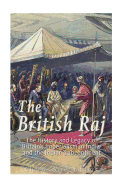Description
| Publisher Marketing: *Includes pictures *Includes contemporary accounts written about the Raj by British and Indians *Includes online resources and a bibliography for further reading “A significant fact which stands out is that those parts of India which have been longest under British rule are the poorest today. Indeed some kind of chart might be drawn up to indicate the close connection between length of British rule and progressive growth of poverty.” – Jawaharlal Nehru, The Discovery of India The British East India Company served as one of the key players in the formation of the British Empire. From its origins as a trading company struggling to keep up with its superior Dutch, Portuguese, and Spanish competitors to its tenure as the ruling authority of the Indian subcontinent to its eventual hubristic downfall, the East India Company serves as a lens through which to explore the much larger economic and social forces that shaped the formation of a global British Empire. As a private company that became a non-state global power in its own right, the East India Company also serves as a cautionary tale all too relevant to the modern world’s current political and economic situation. On its most basic level, the East India Company played an essential part in the development of long-distance trade between Britain and Asia. The trade in textiles, ceramics, tea, and other goods brought a huge influx of capital into the British economy. This not only fueled the Industrial Revolution, but also created a demand for luxury items amongst the middle classes. The economic growth provided by the East India Company was one factor in Britain’s ascendancy from a middling regional power to the most powerful nation on the planet. The profits generated by the East India Company also created incentive for other European powers to follow its lead, which led to three centuries of competition for colonies around the world. This process went well beyond Asia to affect most of the planet, including Africa and the Middle East.. Beyond its obvious influence in areas like trade and commerce, the East India Company also served as a point of cultural contact between Western Europeans, South Asians, and East Asians. Quintessentially British practices such as tea drinking were made possible by East India Company trade. The products and cultural practices traveling back and forth on East India Company ships from one continent to another also reconfigured the way societies around the globe viewed sexuality, gender, class, and labor. On a much darker level, the East India Company fueled white supremacy and European concepts of Orientalism. Ultimately, the company’s activity across the Indian subcontinent led to further British involvement there, and the British Raj, a period of British dominance and rule over India that formally began in 1857 and lasted until 1947, remains a highly debated topic amongst historians, political scientists, the British people, and the people of modern India. It’s necessary to seek an understanding of the people, forces, and events shaping the history of British India to arrive at valid conclusions about the British-Indian experience and to understand the continued divide over its legacy. Perhaps then it’s possible to answer Lewis’s question: “Is it possible that British rule was both destructive and creative at the same time?” The British Raj: The History and Legacy of Great Britain’s Imperialism in India and the Indian Subcontinent looks at the importance of British colonialism in the region, and how it has affected the course of history to this day. Along with pictures and a bibliography, you will learn about the British Raj like never before. |






Reviews
There are no reviews yet.